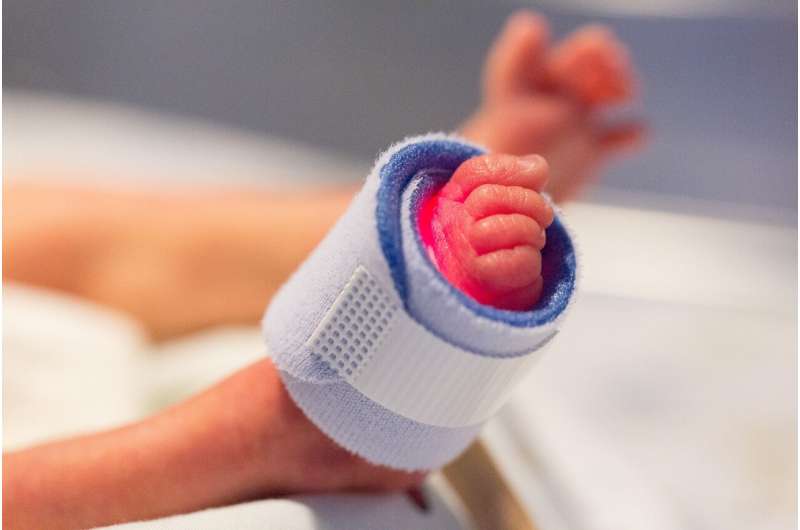This article has been reviewed according to Science X's editorial process and policies. Editors have highlighted the following attributes while ensuring the content's credibility:
fact-checked
peer-reviewed publication
trusted source
proofread
New evidence shows that higher oxygen concentrations may help prevent deaths of preterm babies

Giving very premature babies high concentrations of oxygen soon after birth may reduce the risk of death by 50% compared to lower levels of oxygen, says new research led by University of Sydney researchers.
When premature babies are born, they sometimes need help breathing because their lungs haven't finished developing. To help babies during this process, doctors may give them extra oxygen through a breathing mask or breathing tube.
The study, published in JAMA Pediatrics, examined clinical trial data and outcomes of over one thousand premature babies who were given different oxygen concentrations. This included low concentrations of oxygen (~30%), intermediate (~50-65%) and high (~90%).
The study found for babies born prematurely, at less than 32 weeks (less than three-quarters of the way through a full pregnancy), starting resuscitation with high concentrations of oxygen (90% or greater) could increase chances of survival compared to low levels (21 to 30%).
For comparison, the air we breathe, also known as "room air," only has about 21% oxygen.
When a doctor provides oxygen to babies who need help breathing, there is a device that regulates how oxygen is mixed together to reach the desired concentration. The researchers believe higher initial levels of oxygen may jump-start independent breathing, but more research is required to explore the underlying cause for this effect.
The researchers emphasize that additional large studies will be important to confirm this finding, and that even when starting with high oxygen, it must be adjusted to lower levels quickly to avoid hyperoxia (oxygen poisoning).
How the oxygen is delivered during the first 10 minutes of the infant's life is critical. Doctors may give the baby high levels of oxygen at the start but then monitor vital signs and continually adjust the oxygen to avoid over or under exposure.
If confirmed in future studies, the findings challenge current international recommendations that suggest giving preterm babies the same amount of oxygen as babies born at term, 21% to 30% oxygen (room air), rather than extra oxygen.
This study also demonstrates that there may not be a one-size-fits-all approach, and babies born prematurely may have different needs than babies born at term.
Worldwide, over 13 million babies are born prematurely each year, and close to 1 million die shortly after birth.
"Ensuring very premature infants get the right treatment from the beginning sets them up to lead healthy lives. There is no better time to intervene than immediately after birth," said lead author Dr. James Sotiropoulos from the University of Sydney's NHMRC Clinical Trials Centre.
"The goal is to find the right balance—how do we give enough oxygen to prevent death and disability, but not damage vital organs? While promising and potentially practice-changing, these findings will need to be confirmed in future larger studies."
Historically, oxygen with a 100% concentration was used to resuscitate all newborn infants. But due to studies that found high concentrations of oxygen over time can lead to hyperoxia and subsequent organ damage, in 2010 it prompted changes in international treatment recommendations for the use of blended oxygen (starting with low oxygen) for preterm infants.
However, researchers say the change was mainly based on evidence for full-term infants, who have fully developed lungs and who are often not as sick as premature infants.
To date, there is little conclusive evidence to guide best practice for premature infants.
The researchers emphasize the findings should not minimize the dangers of hyperoxia.
"The debate around exactly how much oxygen is best for extremely premature babies is still ongoing, but ultimately, everyone has the same shared goal of determining the best treatment for newborns," said Dr. Anna Lene Seidler from the NHMRC Clinical Trials Centre. "Our findings, together with all the other research that is currently happening, may help the most vulnerable preterm infants have the best chance of survival."
"We are very lucky to work with a highly collaborative international group on this question, some of whom have been studying it for decades. The group's diverse expertise and experience is a major strength of this work," said Dr. Sotiropoulos.
More information: James X. Sotiropoulos et al, Initial Oxygen Concentration for the Resuscitation of Infants Born at Less Than 32 Weeks' Gestation, JAMA Pediatrics (2024). DOI: 10.1001/jamapediatrics.2024.1848





















